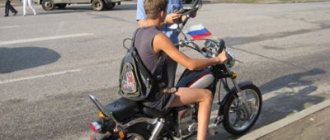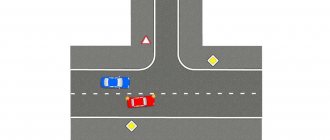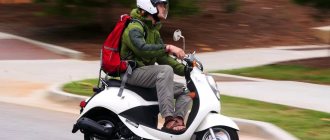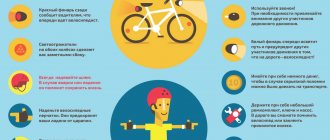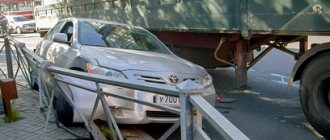Bikers are full-fledged and numerous road users. The system of legal relations regulates the status and responsibilities of a cyclist. But often two-wheeled vehicles cause irritation among car drivers. The bicycle is lost among cars due to its small size and silent movement. According to car enthusiasts, it appears out of nowhere, and the cyclist does not know the rules and does not care about his own safety. To minimize conflict situations, the government approved traffic rules, which are based on the European Concept and national legislation.
Duties of a cyclist
According to statistics, in 2021 there were 5,056 accidents involving bikers. As a result, 382 people were killed and about 5,000 were injured. In 2020, the figure increased by 5%. Driving on a pedestrian crossing and towards oncoming cars, ignoring red traffic lights and turn signals, transporting goods and passengers, and many other violations are the reason for the appearance of a special section in the traffic rules, which stipulates the rights and responsibilities of cyclists on the road. The owner of a two-wheeler must:
- Know and follow traffic rules.
- Monitor the serviceability of the vehicle in accordance with the standard requirements for the technical condition of a bicycle.
- Equip two-wheeled vehicles with a bell and reflectors (white on the front, red on the back, orange lights on the sides).
- Adjust the steering, have reliable brakes.
- Before leaving, check the saddle fastening and inflate the tires.
- Let people pass at crossings.
- Do not be a nuisance on the roads, do not create emergency situations for road users.
- Use special gestures to warn in advance about the cyclist’s desire to change lanes, turn to the side, brake or stop:
- an outstretched arm (right) in the direction of the turn or a left arm bent at the elbow at a right angle indicates the cyclist’s desire to change lanes or turn to the right;
- a change in movement in the other direction is shown with the left hand or the right arm is bent at the elbow at an angle of 90 degrees;
- Before stopping or braking, the biker must raise his straight arm up.
- The cyclist must ensure that the motorist understands his intentions.
- Safety requirements must be observed:
- ride in a single row with other cyclists (up to 10 people);
- drive along the right edge of the road, maintaining a distance of up to 1 m;
- drive around (overtake) cars only on the left side;
- wear personal protective equipment (bicycle helmet, gloves, etc.)
The biker must choose a bicycle path for movement if it is located next to the highway. If there are obstacles (debris, parked cars), move onto the roadway.
Basic traffic rules
To ride a bicycle safely, you must follow the rules of the road, because this vehicle can reach a decent speed - up to 40 km/h, and a sports vehicle with a set of gears - even more. If you speed up and lose control of the situation, you can hit a person and get into an accident. Therefore you need to be extremely careful.
Maneuver signals
When moving along the roadway, bicycle enthusiasts must warn other road users about upcoming maneuvers. Before turning left (right), you must move your left (right) hand to the side. It is worth noting that turning left, except for cases specifically specified in the traffic rules, is prohibited for cyclists. In this situation, before the intersection you need to go down and cross it in pedestrian mode, leading your “iron horse” by the steering wheel, and then get back on the bike and continue to follow the intended route. Before braking, you need to extend your right or left arm up.
When driving in a convoy, another signal is used. It is served to those riding behind. A hand lowered down indicates the presence of a hole on the side from which the limb is lowered. It is better not to use a bent arm at the elbow to give signals (they are for car drivers), so as not to mislead those driving behind.
Lanes and lanes
Road markings are made for cars, so cyclists are only allowed to ride in the right lane closer to the side of the road, so as not to interfere with other vehicles whose speed is much higher. Cyclists are prohibited from traveling on expressways. You can't change lanes either. The exception is making a U-turn when there is no other vehicle on the road.
If cycling enthusiasts ride in a convoy, they must adhere to special rules:
- move only in one row;
- with a bike width of no more than 0.75 m, 2-row traffic is allowed;
- a large column is divided into groups of 10 bikers or pairs (with 2-row traffic);
- a distance of 80-100 m is maintained between groups (to facilitate overtaking).
Bikers are allowed to overtake other vehicles if the maneuver does not interfere with other road users. Overtaking takes place on the left side.
Behavior at traffic lights
Cyclists, like other vehicle drivers, must carefully monitor traffic lights and follow them strictly: stop when they are red and start moving when the light turns green. But they have one advantage - switching to pedestrian mode. If you use this wisely, you can reduce the time you spend at an intersection. When riding on the sidewalk, approaching an intersection, you need to get off your bike.
You cannot cross an intersection at a pedestrian crossing on a bike. You need to drive him. Having completed the transition, you can saddle the “iron horse” again.
If the road has only one lane for traffic and there are no tram tracks, the cyclist is allowed to turn left.
Crossing intersections
When the situation at the intersection is regulated by traffic lights, everything is much simpler. All that remains is to carefully monitor the signals and follow them correctly. At uncontrolled intersections, you need to know the rules for their passage, which are published in the traffic rules. First, all traffic moving along the main road is allowed through. If the roads at the intersection are equal, when driving straight ahead, traffic moving in the transverse direction on the right side is first allowed through. When turning left (which in most cases is prohibited for cyclists), all vehicles moving on the right and directly in the oncoming direction are allowed to pass.
To make the rules for driving through an intersection easier to remember, among drivers there is the concept of “obstacle on the right.” When moving straight or to the left, you must give way to all traffic located to the right of the biker. A car approaching in the oncoming lane, if the bicycle driver decides to turn left in front of him, will also become an “interference on the right”, therefore, you must definitely let it pass.
It turns out that the easiest thing to do at an uncontrolled intersection is to turn right. But for lovers of cycling, it is not easy when there is a car nearby, also turning right. In this situation, the bike may end up in a blind spot, the motorist will not notice it and will begin a maneuver, risking injury to the person driving the bike. The same thing can happen if the driver of a car wants to make a right turn, and the owner of a bicycle is riding straight next to him.
You need to pay attention in other situations as well. Even if you are confident that you are right, before starting the maneuver you should make sure that other drivers see the cyclist and know in which direction he will start moving next.
Transportation of children
Families often use two-wheeled vehicles to take their children to kindergarten. At the same time, they wonder whether transporting children by bicycle is prohibited. Children under 7 years old can only be transported with a special seat, which is attached either to the frame or to the trunk. In the first case, the child can be seen during transportation, and this is a huge plus, but it is much more comfortable for children to ride in the back seat. Children over 7 years of age and adult passengers can also be transported if this is provided for by the design of the bicycle. You can find out about this in the instruction manual.
Behavior at pedestrian crossings
Here the biker can behave both as a driver and as a pedestrian. In the first case, when approaching a pedestrian crossing, he must brake and allow pedestrians to cross the roadway without hindrance. In the second case, the bicycle is driven by the handlebars next to you, moving along the crossing in the same flow as pedestrians.
Illuminated bicycle markings
Riding in the dark is dangerous, so all bikes must be equipped with light markers. Retroreflective elements are installed on both sides of each wheel. There should also be lanterns. The front is white, the back is red.
The greatest danger is driving without illuminated signs in the fall, when there is no snow yet. In such a situation, car drivers do not see a cyclist moving along the edge of the roadway until he falls into the beam of headlights. When this happens, the driver of the car has too little time to react, so the largest number of hit-and-run bikers occurs during this period.
Allowed
Professionals draw attention to the inconsistency of current traffic rules. For example, Candidate of Legal Sciences F. Zeymalov argues: the legal status of a cyclist as a road user needs to be improved. Can a person driving a two-wheeler ride in the outer lane and turn right? Are teenagers allowed to ride on the road or on the side of the road? What should a cyclist do if the directions of travel intersect and the order of priority does not work for the biker?
Where can you ride a bike?
1 . Is it possible to ride a bicycle on the road? You can if your vehicle meets the above requirements and you are over 14 years old. In this case, you must stay as far to the right as possible (although the interval is not indicated in the traffic rules) and try not to interfere with other road users.
This means you don't have to pull to the side of the road or ride along it so that motorists in a hurry don't have to waste time avoiding your bike. Take to the right, but make sure that there is normal asphalt under the wheels, you are also a participant in the movement.
There is another psychological point - a car driver will always try to get between you and a busy oncoming lane at speed if you give him such an opportunity. On a narrow road with oncoming traffic, huddling to the side of the road is simply dangerous - cars will pass right by you without slowing down. It is better to take a position on the road that is understandable to everyone, so that motorists do not have harmful desires.
If a whole column of cars has accumulated behind you, then you shouldn’t be principled - go to the side of the road and let those suffering through.
2. Is it possible to drive on sidewalks? A controversial point that always causes a storm of emotions in the comments. First, let's agree that a sidewalk is just a sidewalk, and not a mixed bike path. Traffic regulations state that cycling on the sidewalk is prohibited for persons over 14 years of age, but right there in Article 24.2 we see the following exception:
Cyclists over the age of 14 are allowed to ride on a sidewalk or pedestrian path in the following cases: there are no bicycle and bicycle-pedestrian paths, a lane for cyclists, or there is no opportunity to move along them, as well as on the right edge of the roadway or shoulder;
It turns out that if it is not possible to move along the right edge of the roadway, you can go to the sidewalk. The right edge of the road is littered, covered with snow, parked cars, construction equipment, etc.
In any city that is not designed for bicycle traffic, the right edge of the roadway will be difficult to access, so you have every right to use the sidewalk, and the etselop has no right to beat you at night, the police have no right to fine you. On the sidewalk, a bicycle has no advantage, and in the event of an accident with pedestrians, the situation will be interpreted against you.
In addition, paragraph 24.6 of the Traffic Regulations states that “if the movement of a cyclist on the sidewalk, pedestrian path, shoulder or within pedestrian zones endangers or interferes with the movement of other persons, the cyclist must dismount and follow the requirements provided for by these Rules for the movement of pedestrians.”
You also have no advantage on a mixed bicycle-pedestrian path; riding there is a very nervous matter, because on the one hand you seem to be on legal territory, and on the other hand, pedestrians consider this place as a sidewalk.
Accordingly, as a rule, people do not control their children and pets, so it is better not to speed up and maintain attention at all times.
Responsibility of cyclists for traffic violations
The regulations contain basic requirements and sanctions for cyclists who break the law. These are the Traffic Regulations (clause 24) and the Code of Administrative Offenses (Article 12.29). Bikers, like car drivers, are road users. Violations are recorded by the state traffic inspector, who has the right to issue a warning, draw up a report, and issue a fine. Administrative responsibility for driving a two-wheeler by a drunk driver is established in clause 27 of the traffic rules. Tighter sanctions are stipulated in the Code of Administrative Offences.
Fines (from 800 rubles and above) are imposed for violating the rules without causing harm to other persons. If people are injured due to the fault of a cyclist, monetary penalties increase by 200–700 rubles. Administrative responsibility begins at the age of 16.
Here is a list of violations that can be punished:
- creating obstructions on the road;
- driving while intoxicated;
- causing harm to the health of another participant in the movement;
- transportation of cargo that does not correspond to the dimensions of the bicycle;
- turning (turning) on roads with tram traffic;
- intersection of stripes indicating one direction;
- towing of vehicles;
- crossing a pedestrian crossing on a bicycle;
- lack of sound signal and reflectors;
- creating an emergency situation;
- riding a faulty bicycle;
- riding without support on the handlebars or with your legs raised on the frame;
- transportation of passengers.
Major violations
The most common violation is cycling in a pedestrian crossing. Moreover, the bikers themselves do not consider this a violation. Drivers are not required to let bikers pass at the crossing, because they are not pedestrians. That's why they are often hit by cars. During school holidays, many children suffer from ignorance of this nuance. Pedestrians can also be injured when the flow is dense and the speed of the two-wheeled vehicle is high.
The second most common violation is driving along the edge of the road in the opposite direction. Pedestrians are allowed to do this if there is no sidewalk nearby. But cyclists do not relate to them when they are sitting in the saddle, although they sincerely believe that in this case they are doing the right thing.
Other disorders that are less common include:
- riding without hands;
- transportation of children and passengers on bikes not intended for this purpose;
- transportation of oversized cargo, when the luggage extends beyond the dimensions of the bicycle by more than half a meter in width;
- driving on highways;
- left turn when there are two or more traffic lanes, as well as tram tracks;
- using a bike as a tow vehicle.
What is a bicycle?
The first and most important concept we take directly from paragraph 1.2 of the traffic rules:
“Bicycle” is a vehicle, other than a wheelchair, which has at least two wheels and is generally propelled by the muscular energy of the occupants of the vehicle, in particular by means of pedals or handles, and may also have an electric motor of rated maximum power. in continuous load mode not exceeding 0.25 kW, automatically switches off at speeds over 25 km/h.
It follows that all points of the traffic rules related to vehicles also apply to bicycles.
Moreover, since April 2014, all bicycles with an electric motor with a power of more than 0.25 kW, which does not automatically turn off at a speed of 25 km/h, are equated to mopeds, which obliges them to have an “M” license and ride with a helmet!
Same point, second important concept:
Therefore, as soon as a cyclist gets off his bike and drives it next to him, all his rights and responsibilities are equal to those of a pedestrian.
Actions of a cyclist after an accident
Unfortunately, traveling on roads also has negative consequences, in the form of possible accidents involving cyclists and motorists.
Many people have the mistaken opinion that most often it is the cyclist who is to blame, since it is generally accepted that this particular category of people does not have information about the rules of the road.
In the event of an accident, you must call an ambulance and report the accident to the police station. In this case, you must not leave the scene of the accident and move the objects of the collision (car, bicycle). It is advisable to photograph the scene of the incident and take contact information of eyewitnesses of the incident.
Best articles: DIY velomobile
It is necessary to wait for a police officer who, having studied the current situation, will be able to make the right decision according to the disputable parties involved in the accident.
Well, in conclusion, I would like to add that traffic rules signs for cyclists are installed for a reason, and if you devote some time to studying them, you can avoid many dangerous situations.
Video about traffic rules for cyclists:
Do you need a license to ride a bicycle on the road?
No, you don’t need a license, and this always causes bewilderment - a person does not know the traffic rules, is not fully responsible for his actions (a fine of up to 1,500 rubles for drunkenness is simply ridiculous), and yet has the right to drive onto the roadway.
In my opinion, it would be logical to issue certificates for cycling on the roads, for example, a day course on the main provisions of traffic rules and an express test for their understanding. Most likely, we will come to this sooner or later. And there is compulsory motor liability insurance, road tax, and technical inspection. Hmm...
Should I wear a reflective vest and when?
Obliged. Reflective vests or capes have already created a lot of buzz since their introduction on March 18, 2021. But few people thought that cyclists are no exception to the Rules.
The obligation to wear vests is imposed by clause 2.3.4 of the traffic rules, and it applies to drivers of all vehicles, and not just mechanical ones - that is, cars.
In addition, paragraph 24.10 recommends that cyclists, when riding in the dark, in rain or fog, install or wear something with reflective elements.
Thus, cyclists are required, in the event of a forced stop or in an accident, while on the roadway or on the side of the road at night outside a populated area, to wear reflective clothing in accordance with GOST.
If you don't have a vest with you
As you can see, the loophole is simple: just leave the road and stand to the side
Please note, you must also get off the side of the road.

